Solving the No CRANK ,
on any Suzuki
If your car won't crank over , it surely can't start! (A/T)
M/T cars can be gravity started or push started !
This page , really works for most cars made. (errata)
Symptoms:, starter is dead,
starter clicks, starter, goes clickity clackity clack?, starter motor
spins, but the engine does not spin. If your car won't crank over , it surely can't start! (A/T)
M/T cars can be gravity started or push started !
This page , really works for most cars made. (errata)
That is the job of starters, to spin the engine, or no A/T transmission cars can start. (the engine spins about 300 rpm cranked, we all that, robust cranking)
The cars battery is only for starting, the alternator charge system runs everything, on with a running engine. (and keeps the battery charged all times, running)
I will attempt to cover every class of failure on this page, (related)
If your car cranks briskly , then you are on the wrong page, hit the back button. ( or my Home button , above right) or go to my No start page.
The 2 all time high causes of NOCRANK is "battery terminals rusty" and you left the lights on and now the poor battery is dead (not bad just discharged) (most folks here, just call AAA tow truck and they jumper cable start it)
Three key factors here, need to be addressed. Did the battery go dead parked over night? or did the battery die driving and car stalled or last did the dash cluster charge lamp go on driving?
Basic electricity, the starter uses about 1100 watts POWER to crank, that is near 1.5 Horse power, if the voltage is low, the starter turns slower, and current drops, as does power and speed.
Ohms law Current is equal to V/R or voltage divided by resistance, by that law, any resistance in the path , results in less current, less power, and slower starter.
This is why we check voltage first, to see if current can flow. (potential)
Just like low water pressure, your yard sprinklers, will not reach the corner of yard, for the same reason. (low pressure,voltage is electron pressure! potential !)
Think of resistance, as a clog in a water line, restricting flow, of water. ( but in a car, in the cables , battery or starter)
Check voltages first, then check for voltage drops, where are those drops at? and how bad are they? Really, that is most of the job , here.
Drops are the losses, seen by the mechanic with his/her meter showing the effects of excess resistance in system parts (wires,connections). If cables are bad rusty ,frayed or corroded, they will have excessive voltage drop. (ohm's law causes that....)
A MACRO FAIL LIST: (I do this Test first, just to see if the Key line, is the problem (saves time) SEE TRICKS of trade HERE:
- You blew a fuse?, check fuses first. (12vdc both sides
of fuses, keyon) (in both fuse boxes !, cab and engine bay)
- Battery failure 12.6 vdc
is normal, rested. If unsure?, us
jumper cables to jump start this car, with a running donor car (AAA car
tow, like)?
- Battery is dead because Charge system
failure, or
the kids left lights on overnight, any light or some audio
upgrades installed wrong.( wrong) Phantom drains?
- Battery cable to starter failure (at any of 4 terminal ends or even the cable itself), very common on old cars
(over 0.5vdc drop test).
- Starter fail. Starters can fail in 5 or more ways, some can
fail and just be weak, (open or shorted internal armeture, brush fail,
bad solenoid) (many autostore tests fail to find weak starters) This car has no BENDIX drive as some think (old farts).
- Engine
seized. (turn it over by hand , is a simple test) Best done Spark plugs
removed. Mine takes about 10 pounds force on 17mm socket wrench to turn (until compression hits)
- Key line fail.
(this is the long
small wire from Ignition key "ST" start lug to the starter solenoid via clutch or Park/Neutral switch) (hot
wire the line at the solenoid ,to test it, in 5min, bingo cranks or not)? if it cranks now?, the key line is dead.
Expanding this idea, we get:
- Battery is
no good. end of
life. (all voltages are at room temperature 70F and rested)
see SOC charts
, state of charge chart.
- Battery not charged
(12.6v is charged) Do you have
Phantom dark currents? aka; parasitic drains? Does battery drain, while
asleep,or while at work?
- Alternator fails to charge
battery to 12.6v (starter fails
after
long drive and battery run down , huh?) Does battery drain driving,
then engine stalls?
- Starter bad
(this includes the pesky solenoid ) Shorted starters, act just like a
seized engine. A a bad slow starter has 11vdc minimum at its
terminals, its bad.
- Seized engine (or
hydra-locked, {head gasket blown| can you turn engine over by
hand.?)} remove spark plugs now, and test the starter, now.
- bad
clutch switch M/T stick shift, top of clutch pedal that switch, bypass
it. start now? This is part of the KEY line.
- bad A/T auto tranny PN switch.) very common. (PN means park./neutral or PRNDL) this is the ST KEY line See KEY line TEST
- Battery cables are bad
to
starter , or some bozo (see note1) put the Minus cable to the
frame and not the starter bolt factory way, or is just loose. SEE DROP TEST.
- Battery lugs corroded.
(an all time top failure for 100 years running)
- The previous owner hacked in
an Alarm cut out on the key line or a goofy wireless remote start
system The ST key line is what is molested here....
look for hacking!
- If starter spins fast, and the engine crank shaft pulley is dead, the solenoid is bad or the flywheel ring gear is stripped. (as you remove starter look in the hole at those teeth ?)
Hackers?,some YoYo? put the starter ground strap from battery MINUS to something else (frame?).
That end lug belongs on the top G103 mounting bolt of starter and it needs to be clean and tight. (as do all 4 cables ends )
One guy did that and blew up body grounds and his ECU. Smoked them!
Battery cables 20years old can have cracked insulation and with 20 years of acid bath, sucked that acid in, and the cables are just green cooper oxide inside, totally useless
Some jumper cables from China, are junk (totally) buy 6 to 8 gauge cables only, never higher number gauge, or they will be useless.
At any time you can remove a charged battery form a good donor car and try it in your dead car, the CCA does not matter, this car starts with only 100 amps.
You can use any Cold cranking Amp rated car battery in this car for testing, excess CCA is not a problem, only battery hitting the hood and shorting lugs, is a big danger.
Never connect up any battery backwards, or you will blow things up. (that includes jumper cables)
If the battery reads 12.6vdc rested and does not drop below 11vdc cranking (at battery terms and at starter acutal , the battery is ok and charged. (in warm climates, not Alaska)
For sure on car starter tests beat any autostore tests, on car, the starter is under full load, and the voltmeter shows what is bad, under live testing and loaded conditions.!!!
Tools: DMM meter, terminal cleaner, 6-8ga. (gage) jumper cables,($30, not $5)
A battery charger 10amps or more, tools sure, add an Ammeter for faster diagnosis As seen tools shown below.
A Battery load bank tester for $20 is nice to own, (all tools here last a life time, and have pay back, first time used, and not towed, all are free !) "Investment grade."
When I was young a voltmeter was (VOM) costs, $1000 in today's dollar, and makes we wonder when kids today, balk at a $10 meter, shocking really.(pun yes!)
See more DIY type low cost tools here.
Read Safety first:
Paths to Success:
There is only 2 paths here, throw parts (guess) and go broke or troubleshoot the problem. There are some fancy techniques to the try !
This document is long because it covers every type of failure, not just a simple bad battery , or dead starter.
I recommend the tools shown below, meter and brush. At least a $10 or $10 Walmart meter is good to have at hand.
Rule #1 ,Starting and cranking are not related failure wise, they are two distinct functions, in a car or truck. ( Electrically speaking , of course)
The starter cranks the engine (turns it fast) the ECU sees that and adds park and fuel, this starts the engine, and then the ECU sustains running, 3 stages of running.
What I am saying here, is that the EFI (ECU) does not crank an engine, and that the cranking (starter) circuit function, is separate . The schemtic is below.
True, if battery is dead, so will be the ECU, EFI and spark. (all electrics dead, or weak, or dim)
Assumptions: Car Push starts and runs. (sorry A/T owners, you can't do that)
Warning #1: do not be tempted to run the car with the battery disconnected, you risk blowing the ECU to kingdom come. (In 1960, this was ok)
The Alternator internal regulator is never to be trusted, A good Alternator does protect overvolatge 2 ways, it's regulator and the huge diodes (actually are zener diode that turn on if over voltage)
These are fails safes, never trust them or play with them, but running battery free. (I warned you !)
The purpose of the starter is simple , to spin the engine over as close to 200-300 RPM as possible. Robust (brisk ?) Cranking.
The starter motor cranks (spins) the ENGINE and the EFI uses that event, to light the fires , the EFI creates spark and fuel and the motor starts.
The Kick OFF:
Turn the Ignition key to the start position (it is spring loaded) and listen to the stater motor, is it silent? , does it click /chatter? or does it make that normal sound?
Grrrr, Grrrrr, Grrrr, varroom. If not? , try my TRICKS -of-Trade here?
Top fails are battery terminals green with corrosion, and bad or dead battery or only a discharged battery !
Things to do , things to check:
Check all fuses first! locate above the left knee panel and on the right inside fender , inside engine bay (hood up).
If they look blown they are , if the look ok, they can be hair line cracked , so use a Resistance meter to test them , removed.
I always use volts mode (DMM) to check fuses, key on, both sides of fuse measure 12vdc , not near 0v.
You can test them in the live circuit with a test lamp or voltmeter.
(They will have 12v on both sides if good, KEY ON) < my preferred method !
Clean the battery terminals. (Caution: Lead toxic and Acid danger): [ Acid. (it will eat your clothing up)] DO NOT RUB YOUR EYES.
The lugs contain lead. Wash hands before eating or drinking.
Remove them and clean them with the brush below and use Backing Soda. (hand and eye protection is ideal) [ lots of fresh water; to flush ]
Always remove the Minus Negative cable first or risk battery rupture or explosion.
Many people are hurt each year, because of this ignorance. (if the Plus lug wrench hits metal, BOOM and the battery can explode SHORTED)
Minus off FIRST then back on LAST:
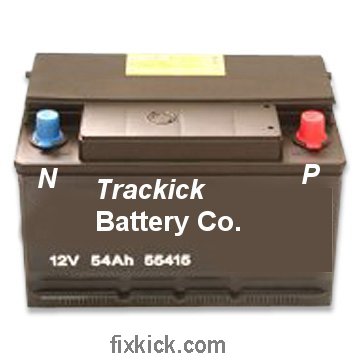

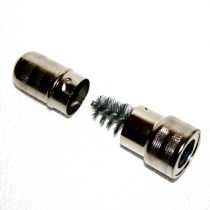
Try to start the engine again. Still dead, very weak , or clicking /silent starter motor?
Dead Starter !
I always grab my voltmeter at times like this, but you can try a fresh known good battery. (DMM digial multimeter)
I then conduct some battery tests, Voltmeter on 20-vdc range, black meter lead to minus battery post and red plus meter lead to Plus battery term. post
First look at this SOC table (photo), and at the open circuit voltage readings. ( this table lets you adjust for ambient temperatures)
The factory battery will read 12.65 vdc at 80deg F . At rest only. ( if battery is used to crank or charged is it not rested) Give it say 1 hour to release the so called Surface charge.
If you have a real fancy expensive $300 AGM battery , or GEL CELL battery, then it will read higher for 100% SOC.(see table again)
12.6v is for stock batteries, only. Some old stock cars fail to charge up 100% that new fancy $300 round cell batteries, so why use them?
If the engine cranks but is real slow, take out the spark plugs, if still cranking slow and engine is not seized, that is a very weak starter.
In this case, I check the voltage directly at the starter cranking, (not at battery) if at 11vdc, and its slow, the starter is bad.
Some autostores tests starters with no load. So you ON CAR tests, is far better than that method.
If the starter voltage is too low (say 9v), then the cables may have drop, if they don't then the battery is bad. (only takes one weak cell, to kill the total battery)
If the voltage is below 50% State Of Charge (SOC) then the starter may only click or turn very very slowly. ( let battery rest for 1 hr before testing with a meter)
At this point we know the state of charge (SOC) on the battery,and if it is bad/poor? , then try to charge the battery or fix the alternator.
Owning a good battery charger , pays back 100% the first time miss having to call a tow truck.
If the SOC, is good? , we will next try to find the reason, for the not starting. In Chapter 1 ,below.
Photo 1: One meter man, ? then the below wins the job. Can find battery drain easy and stater current up to 400 Amps. (may not work well, with HUGE V8 engines)
A DMM with Amp clamp, feature !
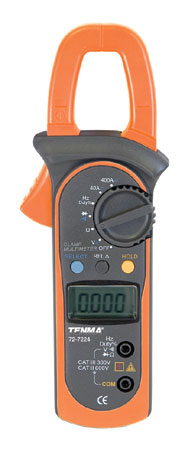 Sold by MCM Electronics(or
Newark E14), it does DC Amp's so easy , its a crime. #72-7224
Sold by MCM Electronics(or
Newark E14), it does DC Amp's so easy , its a crime. #72-7224Here are better tools, the tools at Sears are very good (but do not buy A.C amps , only the D.C amp tool , they cost more than A.C. Clamp tools.
My small engine , the 1.6L draws 100 amps on a suuny day , at the starter cable. (the FSM states that fact too) (1 amp pre cubic inch displacement)
Nicer meters, you can log the current/voltage flow in TIME. See that here. This plot tells it all.
This is voltage plot , you can also do current. I imagine current flow, turn the voltage chart below upside down and imagine 11v is 100 amps. SEE?
The below is NORMAL Voltage. from key on, to running.
DSO "SCOPE , or lab scope PHOTO 2 (yes, scopes do rule !)
The DRAIN (load) is about 100 Ampere's , this scope plot is voltage in time. Note car started, in about 6/10's of a second.!
If the engine did not start the 11vdc would hang there,, sustained until battery got weaker, and drop.
Thus Scope photo tells the whole story, look at that trace carefully, see each event during starts.
See the Alternator wake up? above? (over 12.6v)?
For sure, no better tool on earth is a DSO, and with current probe. (no guessing, period)
A shorted starter? you would see the voltage will go way below 8v. and hang there and the solenoid go NUTS, clattering.
The normal drops above, are caused (mostly) by natural battery internal resistance, no battery yet, acts as a SUPER conductor.
Ohms law (and simple math )
That cell resistance is R = V/I or R = 11/100 or R = 0.11 ohms
(in fact, pro battery shops can test internal cell resistance and tell you furture life of battery!, we did this at 911 call centers, with huge UPS banks and 100s of batteries in series)
This document will try to cover 2 of 3 methods of testing, 1-Throw parts, 2-Active and 3- passive testing.
I will cover Active testing and Passive testing (hot wiring) and never throwing parts. (unless desperate owning only one car?).
Keep in mind the over all picture here , that the problem can be:
Fast & lean Over view: "cause" (when I say starter is good or bad, that includes, the solenoid)
- A dead, discharged or bad battery (find out why?, is just discharged, well charge it.? if it keeps discharging the alternator is dead or you have Phantom drain.)
- Bad batteries can in fact, self
discharge ( if it discharges fast parked on a bench , the battery is
TOAST.
- Corroded battery lugs, at 4
ends, not just 2. (or not tight at all 4 ends)
- Bad battery cables ! (do a
Voltage drop test on them ) , see my simple
drop test for more examples.
- Bad starter ST key line
. Bad A/T PN switch or clutch switch , the hot wire
check tests the key line to prove this easy.
- Engine is
hydra-locked with
, gas, oil or coolant. ( will fail the hand crank test with 17mm
socket wrench on front crank pulley) remove spark plugs and turn again.
- Stripped out /bent fly
wheel
ring gear (rare, but starter motor will spin up real high or will JAM
and
freeze) (visual
inspection of the gears, solves this riddle)
This can be found, with an inline inductive amp meter placed on the starter cables. Max Amps starting, is 200 amps, on 4cyl. sidekicks , < see pg 19 in PDF.
100 amps warm day, or up to 200 cold has heck outside. (like in Alaska)
A hydra locked engine, will read crazy high amps, over 300 amps I guess. I'm checken to try it. (bending RODS is no fun)
The slow starter can be a bad starter with open or shorted, armature windings. (under current or over current, is this clue, 100amps is normal current)
The rule of thumb is 1 amp current per Cubic Inch of engine displacement. (warm days, keep in mind , wrong engine oil on cold days , raises, amps , plenty)
I use this meter to check voltage and current.
The normal voltage at starter terminals direct is about 11vdc. cranking.
Best practice is to monitor the voltage and current (amps) at the starter main feed power cable. (11vdc and 100 amps)
.
While cranking: (worst case, COLD weather ,best test with quality multimeter)
Rules of thumb:?
All solenoids, drop (die out) below 8 vdc. (solenoid maker spec.;s)
The 11vdc is not cast in concrete, it can be a tad less , in cold weather and not running 10-30w oil or lower grades per operator manual instructions..
Even 10v can happen on frigid days. (at starter term.'s)
If the current goes over 200 amps G16 engines) , you have a load problem. OverLoad as in a shorted starter or hydra-locked engine or jammed up starter pinon/ring gears
If the Starter spins up to high rpm without turning the crankshaft (look at the damper pulley) then the solenoid pinion gear is not extending or the gears are stripped out on either end.
If the starter just draws a hug current over 200amps and does not spin then it is stalled/jammed or inernally shorted.
If the starter solenoid kicks back each time you activate the starter, then the starter is either stalled is shorted inside .
Current will be excessive for this fail and voltage will drop to an illegal value below 10v.
Cold cranking Current (CCA) can hit 500 amps, in SIBERIA/Alaska? with wrong engine oil,? and if more, the starter is shorted, or engine seized. 200amps is the normal maximum.
The below meter is an invaluable tool. and is the cheaper tool of the other choices. All machanics should own one, for sure. (or a fancy DMM AMP clamp meter)
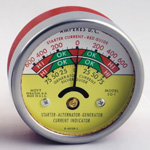 Just press it against the PLUS battery cable. See
starting
current.
Just press it against the PLUS battery cable. See
starting
current.I use this tool for messuring AMPs.(it costs more, but does more)
Chapter 1:
Any no crank, situation:
What can it be?: See Test #1 to find out fast using this tool.
It can be the battery , that stater , the starter solenoid, the ignition switch or wirint to it, or the alternator (dead or simply a discharged battery).
It can be the M/T clutch switch failure or if an automatic tranny , it can be the Park lock out PRNDL switch circuit. ( not to mention contacts and wires between all mentioned).
( Tools: One DMM , digital multimeter, even a cheap $3 meter and a set of remote starter push button (not radio control) jumping wires with clips)
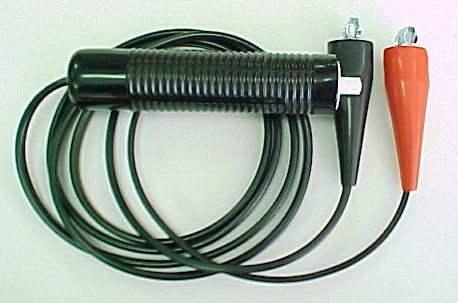 Example Amazon has it. Cheaper that HF !
Example Amazon has it. Cheaper that HF !Look here to see the huge number of makers and sources to the great tool
It is good to own this push button when any starter fails to respond.
Connect one jumper to B+ lug "outboard" and other of ST lug of the solenoid. See photo below for terminals.
SPARK: an other things that can be marginal with low battery voltage.
Ignition spark will die below 9 vdc on most these old cars. (ECU limits) The ECU gives up the ghost below this Voltage.
If your car is missing spark, and cranks ok, then you are on the wrong page, go back.
The starter Solenoid:
Below 8 volts DC (direct current) , under a starting load, the starter solenoid will start clicking madly. ( the solenoid needs above 8volts to function, barely)
At this point you have a good charged battery , so we will proceed with the next tests.
I like short cuts, so I check to see if my battery is good. ( I'm assuming the starter at least clicks when activated, if not skip to Test #1 below)
After cleaning battery terms. and checking state of charge.
I then place my voltmeter above across both battery terminals.
I next crank over the motor with a helper or with the above starter hot wire device jumper set.
This is the battery sag test.
The voltage will sag but it must not sag too much. Not below 10vdc is my rule. (Test "A")
This is an on car load test, and works very good.
If this test fails, I then move my test leads to the starter solenoid connections.
Red test lead to the outboard solenoid lug marked red cable input (it might be a black cable too) the color don't matter just the Position.
The Black meter test lead then goes to the starter case ( use alligator jumpers to find a case screw to attach to)
Repeat the above test and expect 10vdc cranking.
If the voltage is the same as test "A" and too low, then the battery is bad or the starter is shunted/shorted or overloaded, if you have a good known battery, at this test and you have less than 10vdc then the starter is bad or overloaded.
If the voltage is perfect (above 10v) and not cranking, then perform the test below. No or very weak clicking? and 12vdc for this test requires the next Test #1
TEST #1: The KEY LINE TEST or ST start line, (why is my key line DEAD?) This one test cuts the problem in 1/2 , saving huge labor and wasted parts costs.
( your battery is known to be fully charged now and is in perfect order ) [ using a bad/dead or weak battery for this test, is a waste of time]
I put the car on ramps or stands ( if not accessible from the hood ) and get full access to the starter motor.
(On ,my 96, I dismount the manifold brace at the top and tilt it to the right. Starter Motor is accessible now.
Put the car in park (A/T ?) or neutral (M/T ?) and with the emergency brake on and then chock the wheels, with a 4"x4" lumber scrap to make a chock.
Put the 4WD (if you have one) Transfer case in Neutral for the extra margin of safety.
Keys in your pocket. (safety margin 3) The engine will not start, doing this test. We are only testing the key line and starter.
BEGIN TEST: The starter HOT WIRE test.
Step#1: remove the FASTON(tm) connector at the ST terminal below. I like to call it the KEY line (start key activates it , is why , Suzuki calls it ST.
Jump the 2 nodes shown below as a (temporary) switch. See the Large arrows below? Using the Hot Wire jumper.
The big fat red cable lug (aka B+) to the tiny spade lug called ST. Do it only for 1-5 seconds.
Do so, only, if your body is clear of the FAN blades of the engine and drive line.
I always do this, with a remote start button seen above. When I say HF , that's Harbor Freight (sorry no stores, in Canada).
The car will crank and will not start, because the key is OFF.
If you repeat this above test with the key set to the Ignition ON position , the car will start and run. ( you hope ) ( and can get you to work , hint?)
Use a remote start button, to actually start a car this way, as it is vastly safer to do so, but I admit a screw driver jumped over Outboard to ST works great too.
A/T (means autotranny)
Many people find their PRNDL switch bad .
AIRTEX Part # 1S5487 shown on rockauto.com and priced at $315 (crazy !) is the PRNDL switch , IT CAN be removed and cleaned and re-Installed and can work perfectly.
Suzuki PN 24731-57B00 (4sp only) costs. $263.00 (cheaper that ROCKauto, BTW !) at Suzuki . Owning A/T cars has its own related high costs.
M./T (stick shift has no such PRNDL switch) a $20 switch, above the clutch pedal.
Photo 2:
Out board is called B+ by most car makers. (not DIN German, I use SAE spec names only).
The inboard lug is the starter motor DRIVE (runs the electric starter motor inside)
Gain access to these small spade lug (Faston(tm) USA name) See tests details below.
Remove this ST wire before hot wiring it. (it just unplugs easy (pulled) I call the ST wire the KEY line, because it originates the KEY switch.
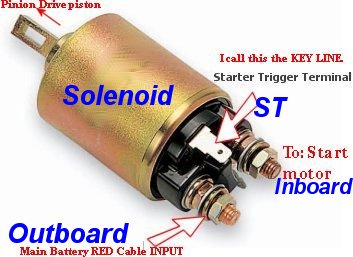 Solenoid
shown removed for clarity.
Solenoid
shown removed for clarity.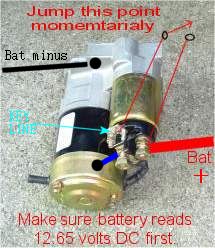 The Sidekick
Starter and Solenoid.
The Sidekick
Starter and Solenoid.The inboard large lug may be missing on some years and is just a black wire, not a lug, on some Kicks or Trackers. (starter bands can have a hidden inboard wire, or aftermarket starters)
The above shows hot wiring the starter, the battery cable red above, can be black on some cars. But is the Outboard LUG !
Notice the red skinny wires ? above, and a switch symbol ? that my remote stater switch or just a screwdriver blade crossing the terminals.
The remote switch is not necessary, it only makes for safer more confortable testing and very safe and easy engine compression testing (ONE MAN JOB, keys in pocket)
Sidekick cars?, there is a bracket blocking access to the starter or EVAP canister, so remove them, will allow access from top of car.
For sure, starter access is not all that easy, on some cars. (poke around and see what you need to do.)
If you have the transmission schematic, you can hot wire at the PRNDL switch or clutch switch for M/T cars. (But if the key line fell off soleniod, the starter will fail)
TEST #1:(brief) Hotwiring a starter SAFELY. (only need a screwdriver to jump it)
| Gain Access to the
Soleniod ( from below,or by removing the EVAP canister) Chock the wheels (tires ona flat garage floor) Keys in pockets, engine will NOT start.! First Put MT transmission in Neutral and the Xfr case in Neutral (If you have it?). PUT THE Auto tranny, in Park. (if super safe? put the transfer case in Neutral) I find a way to JUMP the tiny spade lug terminal to the big red BAT terminal , I use a old screwdriver tip and shank, but a professional jumper button stater, is safest. With the button in place, I can move my body away from spinning crank pulley, fans, etc. I pust the botton, if it cranks robustly , the starter is good, if not see trick #4 |
| Never unhook
the above Big RED Bat cable ,without first disconnecting the Battery
Minus main terminal lug cable (Big Black cable) Never short this connection to the body or any other metal object, ever ! If you ignore this the battery can explode, rupture or throw liquid acid all over YOU, and your car, and more important your EYES ! Never underestimate the battery power. It is very powerful and does get very hot , fast ! , if shorted out. Wear full PPE, safety devices when doing this, and most important ;Goggles (sealed type for chemicals). Have Eye flushing handy at all times. Jumper cable cranking? The 4 ends of jumpers are connected to the running donor car, first, Plus, then to dead car, PLUS battery lug 2nd. The Third is jumper cable minus to donor cars Neg lug. Last connect the last jumper cable munus to heavy engine metal, not the battery ! The battery can have hydrogen gas present and making that last connection, makes a spark ! do so far from the battery, at engine metal. This circuit is NOT FUSED ! Battery cables are unfused. Do not remove any starter or alternator without pulling the battery NEG lug first. Test with this in mind at all times. Please! PPE = Personal Protection Equipment. |
TESTING LOGIC:
1: If the above Hot wire ST jump test starts car , then the ST line is bad in the cab of your car (or at the tranny/clutch switch)
2: The Hot wire test fails. (test #1 above)
2a: No sound?, then the solenoid is dead. (battery power stuck at 12.6v so is good, solenoid is dead for sure ! and double sure if it fails to even click)
2b: Clicks and voltage holds up to 10vdc or more, the stater is bad , or motor hydra-lock or starter pinion is jammed.
2c: Starter motor is short circuited in side. (draws huge currents, and soleniod bounces , and is loud. CLANK)
2d: Starter pinion or related parts are seized.
2e: Starter just spins up and engine don't crank , bad pinion or flywheel ring gear.
If the starter tries to crank and the voltage at the battery is good (>10v) and bad at the starter then the battery cables are bad or not connected properly. > means greater than, in math....
If the battery voltage is blow 10v cranking, the battery is bad, or the cable, or the starter is dead shorted out, use the ammeter to find this dead short current,
Here are some more tests. that find the true causes.
THE Cable drop test: (you suspect bad cables) See my DMM usage PAGE HERE.
All things on earth have resistance as does the battery and cables.
Keep in mind that 200 amps is bunch of current. (power lost is P= IČ x R , losses, note how "I "(current is squared)) this speaks volumes.
In lay terms, high current circuits are punished big time for any excess resistance.
We do this test, any time ,battery voltage looks good, but at the starter terminals, NOT.
This called battery cable, voltage drop.
In fact all wires and connectors in the car can fail , go resistive and have an illegal voltage drop. 0.5v is max. (SAE/ASE rule of thumb and Suzuki's)
Keep in mind the PLUS power feeds, can fail and the GROUND FEED !
Place the VoltMeter leads at each end of the battery and measure the voltage drop cranking, I use jumper clips to do this easy.
The measurement must be below a 1/2volt. 0.50 vdc.
If not?, then the cables are bad. (from end to end something is very very resistive and bad, why to me , is of no imporants, out they come)
With perfect cables and battery, and the car does not start now, then starter is bad. (good battery , good cables and using the hotwire jumper cable)
Gears? huh?
Rarely, the flywheel ring gear is missing teeth and you will hear the starter motor sing up and spin up to high rpm. (or mangled teeth jamming the pinion gear)
( oops , you need a new ring gear or starter pinion, look ! or the pinion shaft is full of filth jamming it up.).
Yes, the starter pinion and shaft sure can be cleaned and lubed, easy.
Battery Cable Drop tests:
What is this test?, well, it is just measuring the voltage on the battery cables, the end to end, voltage drop.
Ideally it will be near zero ,but in reality, all copper has resistance , so my rule is 0.5vdc maximum. voltage drop. (under load, cranking). 1/2 volt.
Drawing 6: Repeat this on both battery cables , end to end Cranking !!!
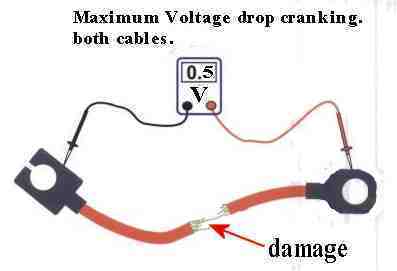
Better quality cables, will have less drop and more power will result, to the starter motor. Typical drain is 100 Amps, cranking. (1.6L, engines, more with bigger engines)
Last comment on the Drop test.
Measure from the battery actual MINUS terminal to the starter casing when doing the ground cable test. (this trick, checks all grounds at once.) G103 lug lose or corroded.
That way , all possible fail points will be tested on this path.
One last good web page on drop tests.
STARTER IS GOOD, now what?: (my KEY line hot wire test , passed the test)
ST KEY line FAILURE !
If NOT , time to buy a new starter. Buy one with a life time, guarantee. (at one store, one car after 500k miles, they had give 3 free starters , life of ownership of car. long)
At this point the starter works perfect when HOT wired, as we just did above.
Begin STARTER GOOD but ST KEY line is failing tests. ST means start line.
TEST #2: (HOT WIRING THE STARTER ABOVE CRANKS GOOD)
At the ignition switch we have No Crank , again:
This is an indication that the stater key line called ST, is dead. (remote hot wiring of starter passes)
This can be caused by:
Bad wires and connections.
Bad ignition switch , clutch or park switch or some crummy after market alarm system or even factory alarms ( common).
Immobilizer? (non USA only) If you have alarm issues,, I can not help you. I have no documentation on any aftermarket alarms.
You must examine every inch of the ST line to find out what some Hack did you your car. (assuming a none OEM alarm here)
To find the problem , work backwards , to the ignition switch from the starter.
I would next check the M/T clutch switch and make sure it is good with the DMM voltmeter. < skip this check if you have an automatic tranny.
M/T means manual transmission,so A/T means...yes. auto.
You can also check it live, by putting the voltmeter Plus lead to the Clutch switch contacts and see if you get 12volts at the switch (both sides) during cranking.
If you get no key line voltage on the output side of this clutch switch , this switch is bad, if it has missing 12v on the input side of said switch .
If you get less than 10v, this line is shorted to something. (or you forgot to do the firts tests above)
If the input to this clutch switch, is bad ( while in key crank position) ,then the problem is up stream , towards the ignition switch.
Input to Clutch switch is near 0 Volts:
At this point I'd pull the covers to the steering column ignition switch section and see if my start voltage , "key line" is in fact originating from the start lugs of this ignition switch?
I say clutch switch , all over this document , you can substitute Automatic Park Neutral switch. ( easy huh).
If the "ST" Keyline (starter small lug) is at zero (below 10v) volts during cranking , at the ST lug of the starter then you have:
- Bad A/T PRNDL switch
(center of photo),
this tells ECU what gear you are in, and allows safe cranking so try to
start car in Neutral, that can start the car with worn PARK contacts.
- or bad clutch switch above clutch
pedal ( M/T stick shift car)
- Bad Ignition Switch. (ST contacts worn out) {having 20 key
on the key ring guarantees this to happen fast}
- Bad wiring between starter ST pin , tranny PRNDL , or clutch switch and Ignition switch ST pin.
- Bad connectors in all 4 paths above.or Hacked wiring.
- Bad Alarm cutout device added, hacked with
wireless remote starts, or car has the factory Immobilizer, if yes ,
then read the glove box
operators guide. (free at all dealers and online)
Starting is blocked by the clutch M/T or the A/T shifter all cars in the USA. (by laws) to prevent accidents while cranking in gear.
The key lines on many cars have been HACKED, that is, added devices, like alarms, audio gone wild, remote start bull. and who knows?, inspecting every inch of the key line, finds these little horrors.
I can not tell you, how to troubleshoot any alarm (there are too many types,made aftermarket) and point 2 the alarms vary by country. Even factory alarms and inhibitors vary by country.
My style is to remove alarms.. I hate them. (and the endless noise.), I like secret fuel cutting devices....
Chapter 2: (phantom battery drains....etc)
Alternate failures:
If your good battery keeps discharging overnight., then the car has dark current (aka: phantom drains, and parasitic drains.)
If your good battery goes dead driving 20 miles or so. then the Alternator is bad or its wiring is bad. Driving with Headlights on , will stall the car quickly with the Alternator dead.
However I drove for 35 miles one time with a dead alternator, with HL off and all accessories off. Just Ignition on , nothing else. Then engine died (stalled)
(my regulator blew out , my dash Voltmeter , alerted me to this fact)
This document is simplistic, one can have harness ground outs and other problems, but this page covers the lions share of issues.
Full schematic below: (click dwg. blow , to zoom it) This is and alarm free car.

Acid Test for Solenoid:
See the VM , above (volt meter) , connect the black lead to the metal shell of the solenoid and the positive lead to the tiny lug shown, then crank, the solenoid must make a loud clack or the starter must crank, of you get neither , and the voltage is 10v or more, then the solenoid is bad. ( this is a passive test)
See VM above in grapic , check the voltage cranking at the node shown then at the NCA terminal just to the left. on solenoid?
The test must be over 10 vdc cranking . Here is a scope view of this happening. (good view and motor starts)
I check this 4 times, using the solenoid as ground and the starter casing. you want to see the voltage AS THE STARTER SEES IT !
VM can be DMM, DVM , any meter that can measure voltage.
This is at warm temperatures, the battery voltage will be less or more depending on the actual battery temperature 12.6v is normal Changed state.
Place an inline (RED CABLE ABOVE) inductive Amp meter to the above red battery cable and measure the starting current.
100 amps 10-13v typ. (mush over this , in warm weather is a shorted starter) {you need a special inductive clamp Ammeter to do this }
200 amps max (cold weather)
Currents over 200amps , are suspicious on this tiny 1.6L engine.
Ask question here, for free, many online helpers.
The Starter Pinion. (self start , not a Bendix drive at all ) Part of the Solenoid .
This is "Solenoid DRIVE gear",with an over-running clutch.
 Self start pinion with overrunning sprag clutch.
Self start pinion with overrunning sprag clutch.The starter solenoid actually forces this unit in to the fly wheel, If you are slow to release the ignition key, the above clutch slips. (preventing starter overspeed and self destruction)
IF this device is rusted or damaged or gunked up, it will malfunction. It must slid freely. Some times just cleaning part, solves all the problems.
The gear on the end, must not be stripped out, nor the ring gear it mates to , mangled or warped.
The clutch on the end must only slip , in one direction.
The clutch on the end keeps the Engine from overspeeding the starter and blowing it to kingdom come via INSANE RPM's. Even if it sticks out!
The solenoid itself can jam, or the contractor inside can fail. (2 ways, stick (short) or go open circuit)
Now you see why most savvy folks replace the whole starter ,not wanting to guess, or test why the 10 ways to fail, are happening now. (there lots of failure modes, why more that listed here)
Myth #1 debunked: (used from 1914 to 1970's) Not seen in 40 years. (land loves to wreck flywheel ring gears)
This is a Bendix drive that is NOT USED ON ANY SUZUKI: (this Bendix works totally different than the above , the Bendix is a "Inertial" drive (relic) This force causes the pinion to slide down the spiral spline for engagement.
Whole Starter:
The solenoid is really many devices, working in concert, the pinion, clutch ,the solenoid proper and the electic power contactor,(a high power relay)
The coil in the solenoid has 2 coils, for for engage, and 2nd for hold, either can fail, As can the contacts burn to a crisp with use.
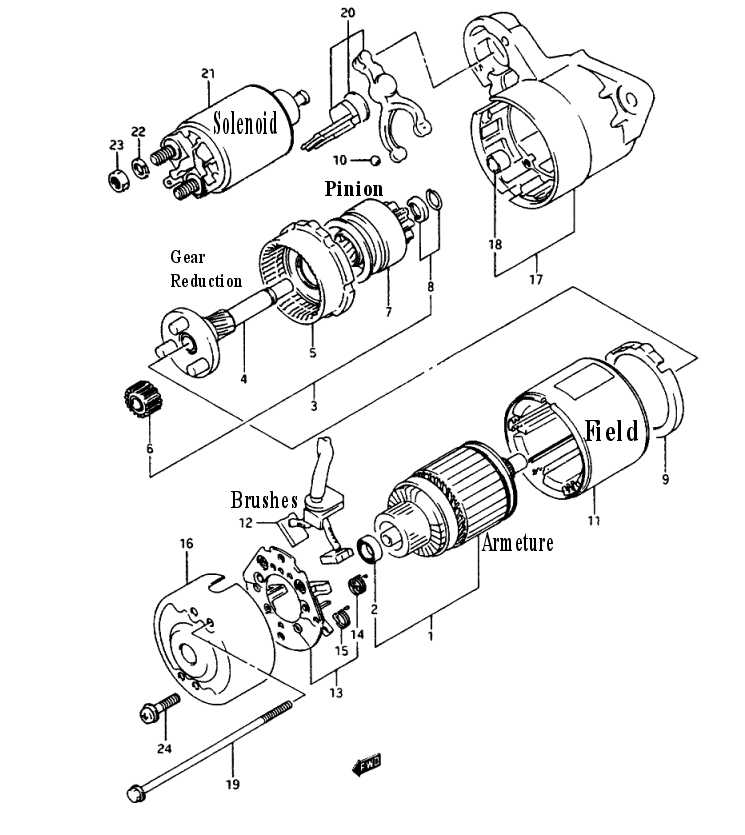
Note: Suzuki sells even the inside parts (few MfG do that )
TRICKS?: (tricks of the trade)
Do I need to say clean the battery lugs? or the make sure the starter ground cable end, is tight, at the starter? Nah !
(yes, Tricks are for kids?, but ... are they?, ever got stuck in a snow bank? with no crank up?) Up Poops creek with no paddle? or SOL? Just joking here, but not below.
These tricks assume all else is good and tested, (battery and battery cables)
- A/T (auto trans) wiggle
the shift lever in park, while you twist key to crank it over. Bad
PRNDL switch.
- Same car, shift into Neutral (A/T) the uses near Virgin PRNDL contacts, bingo it starts.
- M/T (stick?) wiggle the clutch foot while crank, that is push it farther, yet to floor, cranks now? bad clutch switch, all the above are bad switches.
- Take a hammer, and hit the starter cases, smartly, not to do dents, but to wake it up.. (starters have at least 3 ways to go asleep in side, wake it up.) {brushes,pinion jam, solenoid jam,etc)\}
- Wiggle the starter key a tad more aggressively in the crank posistion, (even use what pool player call, side "English", that is different side angles on the key)
- And last of all , I wiggle the harness below steering to switch, and above starter.
- My car (say) has a bad
battery or starter. so I parked on a hill every day and did a rolling
start up , dumping the clutch in 2nd gear. works every time.
Stick shifts rule earth !
- Or push started
(stick shifts do rule)
Yes, A/T transmissions are weak technology, I really do hate them, and there 100 leaking o-rings and seals.
Trick #9 (beats walking 25 miles?)
Now my last trick. my battery far from home, in the STICKS (woods), decided to have a bad cell, just one cell bad , and now is a 10v battery, no crank up!
I removed the battery , with my spare gloves in truck, and put the battery in the ditch, and rolled it end for end 3 times. (3 for luck, LOL)
Bingo 12v was back, (I carry a volt meter for life (over 50 years).
(a battery internal cell can short, from lead mud, on the bottom of the case, this clears, that short and you leave the woods , happy)
The battery can have a cracked internal strap , and beating up, a battery like above, can remake this connection, for 1 more good start.
I started car and drove home, and then bought a new battery.
PARTING SHOT:
I'm for sure, no advocate of using cheap tools, (Harbor Fright, takes the cake,IMO !) but most owers of cars, that is DIY are strapped for time, or cash or fill in the blank.
Some tools are so cheap, HF, they only last for 1 job. For sure the $4 DMM (POS) is great in an emergancy, it's not long lasting for sure, (in a pinch). DMM= Digital Multi Meter
Walmart has one for $10 or the nicer one for a whole $20.
If in jam and need a DMM fast, all Walmarts sell this one, for under $20 bucks. and is not a bad meter !
Did you charge that battery first? ( $14 bucks up) Harbor Fright (pun) Has em. and every car store on earth.
Why pay $125 for a new battery + labor , when you can charge it , after leaving your lights on. ( use it for a LIFE time of car ownership)
It's free, if it saves one repair bill. Do the math?

After you charged it, did you load test it?
With this? (it just a very power full load bank resistor and a cheap meter, it works great)
Tests the battery and sees alternator work, or not.

errata:
The words, my engine won't turn over,means nothing to me ,at all.
The starter spins and turns.
The Flywheel and crank turns and spins as does cranks shaft pulley in full view to see.
The engine then starts and then runs. (yes the engine too, turns and spins much faster, 800 rpm now or more, but not 200)
Avoid the word turns. it tells the helper nothing, with out using the full statement "what turns or not a Noun". (ah, starter turns but engine will not turn , is clear)
My car will not crank over, is best. (crank pulley DEAD, won't spin, means fails to crank)
Our engine cranks fast, but will not start. Is better ,no?:
Engine crank, starts then stalls. (on more for the list?) or add starts, stalls and will not start for 2 hours.?
Before starters?we hand cranked engines, we did not hand spin them., thus the term crank shaft. (I own 2 cars (had 3) that hand crank and 5 motorcycle , same deal (by foot)
rev 10 . 12-4-09 clean up, and added more details so some parts. 2 more photos at end.
10-10-2013 (small edits, and safety added and made more generic ) ,
1-.8-2013 tricks,
9-2014 (added more photos and many edites and cross links )
